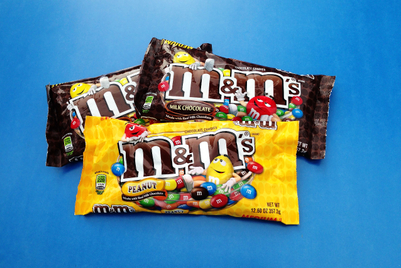
Throughout a conversation with Andrew Clarke—at the time of the interview Mars global CMO but now global president of Mars Wrigley Confectionery—one word and one phrase recur: ‘balance’ and ‘test and learn’.
These are two fundamental principles for the marketing head of one of the world’s biggest advertisers, and as the interview continues it’s clear they can be readily applied to almost any aspect of the modern advertising, marketing and communications landscape.
Moreover, given Mars was the most awarded advertiser at Cannes Lions 2017, taking home 44 awards, there’s a fair chance Clarke knows what he is talking about. And what he talks about most often is innovation.
We have 80% of our media budget on established, proven channels that have got proven ROI, 15% for testing and learning.... And then 5% is just out there, to just try new, very innovative stuff.
“It’s getting that balance right of providing enough space to innovate, but with some clear guidelines because you don’t want complete chaos,” he explains. “You want to scale things but at the same time, you want enough freedom to try things. It’s a rapidly evolving space.”
Keeping abreast of new developments, and sometimes being ahead of them, is critical to Mars’ global marketing and communications strategy, says Clarke, and you can’t do that by being risk-averse. It might be easy to suggest that Mars has more licence than most to try new things, given its size and resources, but Clarke posits that it is precisely the brand’s willingness to innovate throughout its history that has led to its increasing success.
He breaks it down approximately as things stand today. “We have 80% of our media budget on established, proven channels that have got proven ROI, 15% for testing and learning, and proving out, or if it doesn’t work, take the learnings,” he lays out. “And then 5% is just out there, to just try new, very innovative stuff.”
Clarke believes Mars’ strength has been the ability to combine what he calls the brand’s “functional brilliance” in marketing and media with “being future-oriented” in its strategy. For him, nowhere is this better crystallised than in Snickers’ much-lauded ‘Hungerithm’ campaign of a couple of years ago, which was created in Australia but then went global.
Part of having the ability to produce such campaigns is having forensic local insights, which is why Clarke has strong local teams. “It’s very much a decentralised business,” he says. “We’re often doing creative that travels many countries, but crucially allowing the local teams to innovate around that.
“We try to keep our regional teams pretty lean actually, because we believe in having expertise in the local markets, but crucially then scaling, so when we get something that works, we can replicate it quickly across the world. So that’s the balance.”
In Asia-Pacific specifically, Clarke says Mars is proud of its long history in the region and is investing heavily, particularly in China. Partnerships with the likes of Alibaba and Tencent, as well as many other tech platforms, has given the brand access to a wealth of local consumer data that is being turned into insights and innovative new products—based on Chinese taste profiles, Mars launched Snickers Spicy last year, Clarke highlights by way of example.
In extolling Mars’ successes, both in APAC and globally, Clarke is happy to share the credit with the brand’s agency partners. Again, he repeats, it’s a balance between long-term partnerships with the likes of BBDO and DDB for creative, and Publicis and MediaCom for media, and working with smaller outfits required for specific projects “but in a very managed way, otherwise we end up with thousands of agencies and we lose that ability to have expertise that really understands our business”.

“We really challenge those agency partners to push themselves, to have the best talent possible on our brands and with our business,” Clarke states, “and to push each other so we continue to innovate.”
So what about bringing things in-house, a topic raising eyebrows at many agencies? Clarke doesn’t give much away, saying the issue is being looked at “in certain areas”, with a few creative pilots having been carried out in the US. But right now, many Mars’ marketers are embedded with agency partners and it’s working, he says.
However, he sounds a note of caution for agencies in amongst the praise, somewhat unsurprisingly regarding digital advertising and transparency.
“Proving out [campaigns] in digital channels is critical,” Clarke explains. “It’s very easy to throw money at it and not get the return. We’re one of the world’s largest advertisers, so making sure we spend our dollars to get that return is critical.”
At the heart of everything, I still love amazing creative. In this cluttered media that we’re all bombarded with, what really cuts through is still brilliant creative.
Inevitably the conversation moves to ad fraud, and here Clarke also issues a light warning as he explains how fraud is a frequent topic of conversations with agency partners. “We spend about 30% to 35% of our media dollars on digital platforms. I would expect that number to increase, but it will increase when we’re confident we can prove out the ROI, and it’s not always easy to do that.”
So to avoid any sticky situations, it seems Clarke is advocating more testing and well, more learning. But for all the innovation and new technology out there to play with, Clarke says fundamentally a brand’s success comes back to one constant.
“At the heart of everything, I still love amazing creative,” he says. “In this cluttered media that we’re all bombarded with, what really cuts through is still brilliant creative. Having said that, I think the blending of brilliant creative with innovative new ways—VR, AR, AI—that can drive marketing in very new ways is fascinating.”


.jpg&h=334&w=500&q=100&v=20250320&c=1)


.jpg&h=334&w=500&q=100&v=20250320&c=1)
.jpg&h=334&w=500&q=100&v=20250320&c=1)
.jpg&h=334&w=500&q=100&v=20250320&c=1)

.jpg&h=334&w=500&q=100&v=20250320&c=1)







.jpg&h=268&w=401&q=100&v=20250320&c=1)

